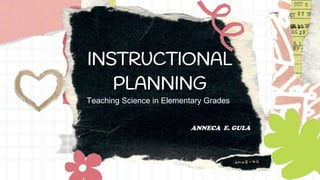
Instructional Planning_123757.pptx
- 1. INSTRUCTIONAL PLANNING ANNECA E. GULA Teaching Science in Elementary Grades
- 2. Tell me and I forget. Teach me and I remember. Involve me and I learn. – Benjamin Franklin
- 3. Lesson Objectives At the end of the lesson you are expected to: 1. Describe to a colleague your typical instructional planning process; 2. Identify events that must be included in an instructional plan; 3. Examine the elements of an effective instruction and their relationship; and 4. Characterize an effective instructional plan.
- 4. What is Instructional Planning? Is the ability of the teacher to visualize and forecast into the future of what, why and how of the teaching-learning process. Teachers use this as a way to design what topics or what objectives, students will learn, and how they will get them to learn the material.
- 5. Types of Instructional Plans LONG-TERM INSTRUCTIONAL PLANS SHORT-TERM INSTRUCTIONAL PLANS
- 6. ○Yearly Plan: Instruction plan that covers a school year (from April to March in Japan). ○Monthly Plan: Instruction plan that covers a month in order to put the yearly plan into practice. ○Weekly Plan: Instruction plan that covers a week and is formulated concretely in order to put the monthly plan into practice, paying attention to the continuity of life. ○Daily Plan: Instruction plan that covers a day and shows the life of children at kindergarten in detail. Long-term Instruction Plan Short-term Instruction Plan
- 7. EXAMPLES OF INSTRUCTIONAL PLANNING: 2. Unit plan 3. Lesson plan 1. Course plan
- 8. What are the elements of Instructional Planning? Learning Environment This supports all students to take risks, ask questions and make and learn from mistakes. The physical space, routines & procedures, and development of positive relationships create physically, socially, and emotionally safe environment. 1. . Clear, Shared Outcomes The learning outcomes are shared and internalized by teachers and students. These outcomes anchor and guide the choices of instructional activities, materials, practice assignments, and assignment tasks. 2.
- 9. Varied content, Materials & Methods of Instruction Students explore ideas and information in varied ways and access learning through multiple entry points. Teachers select contents and materials to engage and meet the needs of all learners. 3.
- 10. What are the elements of Instructional Planning? Practice and Feedback Students have the opportunities to practice what they are learning and are given timely, specific feedback based on their current performance in relation to the desired outcomes. Complex Thinking & Transfer Students are coached and taught to engage in hihger order thinking through instructional activities and practice tasks. Curriculum, instruction and assessments are designed to prompt complex thinking, integration of concepts & ideas, and applicatioin of learned skills to new material or novel situations. 4. 5.
- 12. GAGNE’S Nine (9) events of Instruction
- 13. 1. Gain attention of the students. 2. Inform students of the objectives. 3. Stimulate recall of prior learning.
- 14. 4. Present the content. 5. Provide learning guidance. 6. Elicit performance (practice).
- 15. 7. Provide feedback. 8. Assess performance. 9. Enhance retention and transfer.
- 16. You have an effective instructional plan if you can... Identify quality materials and strategies for instructional planning Compare direct and discovery instruction Explain how to select educational resources for diverse students Share the role of motor and sensory education in early childhood Describe the advantages and disadvantages of cross-curricular teaching Discuss interdisciplinary classroom activities
- 17. BENEFITS OF INSTRUCTIONAL PLAN ON TEACHING Explore specific planning methods to foster growth and development in teachers and students. Consider research that establishes the effectiveness of instructional planning strategies and methods. Discover how to move from research to practice in delivering effective planning and instruction. Access ready-to-use handouts to immediately implement proven planning methods and strategies. Review principles for planning instructional practices as a team.
- 18. How to characterize an effective instructional plan? 1.Be Adaptive 2.Focus on concepts and principles. 3.Take into accounts that student's ongoing cognitive activities. 4.Not replace the student's ongoing cognitive activities.
- 19. Instructional planning is an important way for teachers to strategically decide what their students will learn and how they will learn in it. An important factor of instructional planning is using differentiated instruction to meet the various needs of all students. What is the importance of Instructional Planning?
- 20. Thank you! If you are planning for a year, sow rice; if you are planning for a decade, plant trees; if you are planning for a lifetime, educate people. – Chinese Proverb